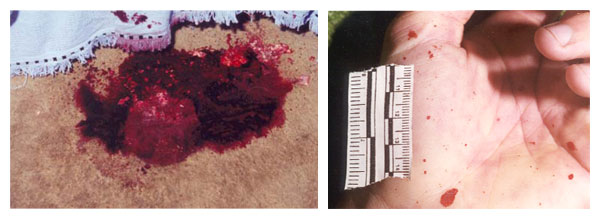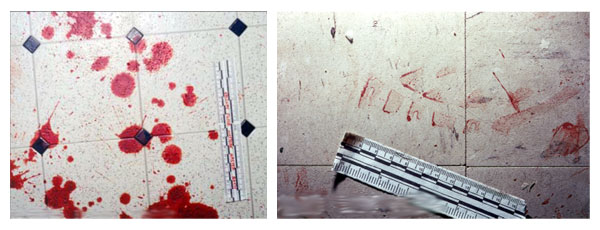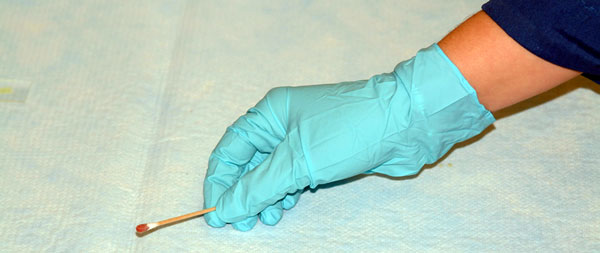How It’s Done
Bloodstain Patterns that May be Found
Bloodstains range in both amount of blood and type of pattern—from pools of blood around a body to obvious spatter patterns on the walls to microscopic drops on a suspect’s clothing. The shape of the bloodstain pattern will depend greatly on the force used to propel the blood as well as the surface it lands on. Forward spatter from a gunshot wound will typically form smaller droplets spread over a wide area, while impact spatter will form larger drops and be more concentrated in the areas directly adjacent to the action.

Left: large volume blood stain. Right: impact spatter pattern.

Left: passive bloodstains. Right: bloody shoe print transfer pattern.

Left: void patterns. Right: projected blood stains. (Courtesy of John Black, Ron Smith & Associates)
Because blood demonstrates surface tension, or cohesive forces that act like an outer skin, a drop of blood dropped at a 90° angle forms a near-perfect spherical shape. A smooth surface, such as tile or linoleum, will cause little distortion of this spherical shaped drop, whereas a rougher surface, such as carpet or concrete, disrupts the surface tension and causes the drops to break apart.
The number and location of stains, as well as the volume of blood influence how much useful information can be gathered. Large amounts of blood, such as if the person bled to death or was so severely injured that the resulting blood spatter was extensive, can often yield less information than several well-defined spatter patterns. Too much blood can disguise spatter or make stain patterns unrecognizable. Conversely, too little blood, just one or two drops, will likely yield little or no useable information.
Stains that overlap or come from multiple sources present challenges to analysts, but often reveal valuable details about the crime. Overlapping stains may obscure pattern details, but can provide information on the force, timing and instrument used. In the case of multiple victims, analysts will often use DNA profiling to determine whose blood is included in a given pattern, helping to estimate the locations of the victims in relation to each other and the perpetrator(s). Learn more about DNA ▸
How Bloodstain Evidence is Collected
Bloodstain samples can be collected for BPA by cutting away stained surfaces or materials, photographing the stains, and drying and packaging stained objects. The tools for collecting bloodstain evidence usually include high-quality cameras (still and video), sketching materials, cutting instruments and evidence packaging.
Documentation of Bloodstain Evidence
The most frequently used method of capturing bloodstains is high-resolution photography. A scale or ruler is placed next to the bloodstain to provide accurate measurement and photos are taken from every angle. Video and sketches of the scene and the blood stains is often used to provide perspective and further documentation. This is commonly done even if stained materials or objects are collected intact. Learn more about Crime Scene Photography ▸

A crime scene photographer documenting blood spatter evidence on a wall. (Courtesy of NFSTC)
Sampling Bloodstains For DNA Profiling
Analysts or investigators will typically soak up pooled blood, or swab small samples of dried blood in order to determine if it is human blood and then develop a DNA profile. This becomes critical when there are multiple victims. DNA profiling may also indicate whether the perpetrator was injured during the attack, as in the case of two DNA profiles found at a scene with only one known victim.

Collecting a blood sample with a swab. (Courtesy of NFSTC)
Whenever possible, analysts or crime scene investigators try to collect the evidence intact. This may require removing a section of a wall or carpeting, furniture, or other large objects from the crime scene and sending them to the laboratory for analysis. Items that cannot be removed, such as a section of concrete flooring, will be thoroughly photographed and documented. Learn more about Crime Scene Investigation ▸
Who Conducts the Analysis
Bloodstain pattern analysts can be found at all levels of crime scene investigation: from law enforcement to laboratory staff. Analysts investigate and study patterns at the scene and often screen and profile the blood in the laboratory as well. It has become more common for bloodstain pattern analysts to have a degree in math or a physical science, such as biology, chemistry or physics. This helps the analyst to corroborate findings from other scientific disciplines including pathology, toxicology and serology/DNA. Analysts are typically required to undergo formal training in blood pattern analysis, accompanied by competency testing and periodic continuing education. Certification is offered by International Association for Identification (IAI) but is usually not required.
The FBI’s Scientific Working Group on Bloodstain Pattern Analysis (SWGSTAIN) maintains guidelines for minimum education and training for bloodstain pattern analysts.
How and Where the Analysis is Performed
Bloodstain analysts use established scientific methods to examine bloodstain evidence at a crime scene including information gathering, observation, documentation, analysis, evaluation, conclusion and technical (or peer) review. All tests and experiments should be able to be reproduced by independent analysts to ensure accuracy and quality.
Outside consultants are used frequently depending on whether there are any trained analysts in the jurisdiction. The location of the analysis will also depend on the complexity of the case and whether expertise beyond that of the local analyst is required.
Bloodstain pattern analysis is performed in two phases: pattern analysis and reconstruction.
1. Pattern Analysis looks at the physical characteristics of the stain patterns including size, shape, distribution, overall appearance, location and surface texture where the stains are found. Analysts interpret what pattern types are present and what mechanisms may have caused them.
2. Reconstruction uses the analysis data to put contextual explanations to the stain patterns: What type of crime has occurred? Where is the person bleeding from? Did the stain patterns come from the victim or someone else? Are there other scene factors (e.g. emergency medical intervention, first responder activities) that affected the stain patterns?
To help reconstruct events that caused bloodshed, analysts use the direction and angle of the spatter to establish the areas of convergence (the starting point of the bloodshed) and origin (the estimation of where the victim and suspect were in relation to each other when bloodshed occurred).
To find the area of convergence, investigators typically use string to create straight lines through the long axis of individual drops, following the angle of impact along a flat plane, for instance the floor or wall where the drops are found. Following the lines to where they intersect shows investigators where the victim was located when the drops were created.
To find the area of origin, investigators use a similar method but also include the height calculations. This creates a 3-D estimate of the victim’s location when the drops occurred. For example, if the area of origin is determined to be only two feet above the area of convergence on the floor, the analyst may presume the victim was either lying or sitting on the floor. If it is five feet above the convergence, the victim may have been standing. This analysis can be done using strings and a protractor, mathematical calculations or computer models.
Tools used to determine area of convergence and area of origin include:
- Elastic strings and protractors
- Mathematical equations - (tangent trigonometric function)
- Computer software programs such as BackTrack™ or Hemospat
- Limiting angles method, which examines the physical evidence to exclude angles from analysis (e.g. if blood is found on the underside of a desk or table, analysts know that at least a portion of the spatter-producing event took place below the height of the desk or table.)
BPA can range from investigation and analysis of bloodstain patterns at the crime scene to bench work in the laboratory analyzing and DNA profiling the blood. Limited analysis can also be done using only photographs of the scene.